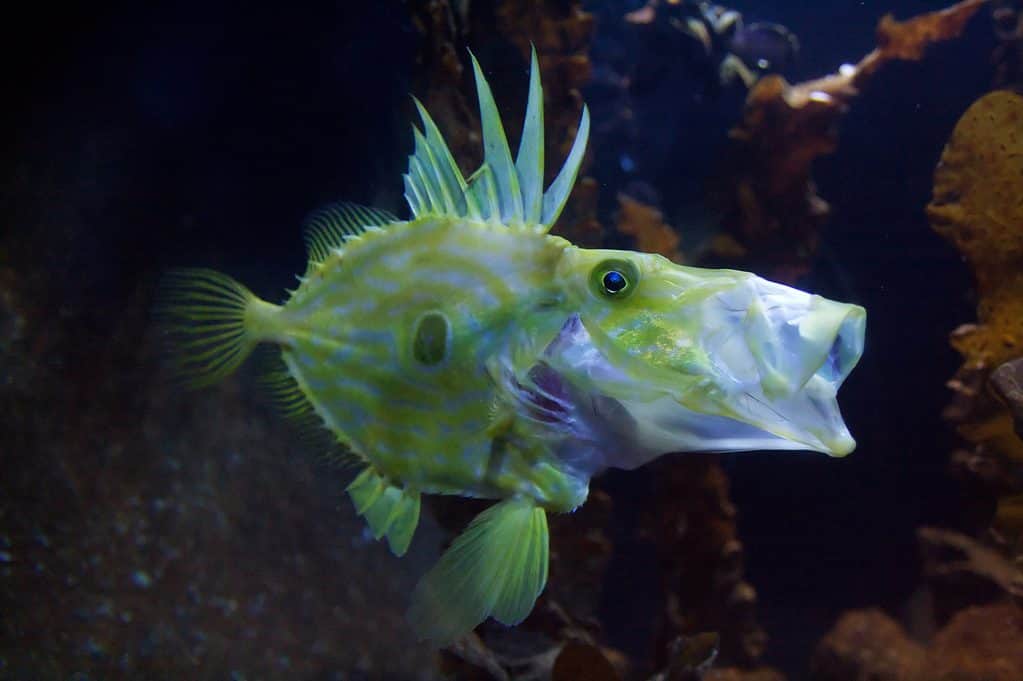Situated on South America’s Pacific coast, Peru is rich in wildlife. Its privileged geographical position allows it to share in the vast diversity of the Amazon River and Amazon Rainforest. Because of this, its marine and freshwater fish come in all shapes, sizes, and colors. Read on to discover 8 spectacular fish found in Peru!
1. Cortez Rainbow Wrasse
One of the most incredible fish found in Peru is the Cortez rainbow wrasse (Thalassoma lucasanum), a marine fish that lives up to its colorful name. This species comes in two color phases. The first occurs in juveniles and initial phase fish and consists of black, red, and yellow horizontal stripes. The second occurs in terminal phase males (that is, females that have changed sex to become males) and consists of a blue or green head with a bright yellow stripe, a red body, and a purplish-blue tail. Females of this species may change sex in the absence of available males.
These flashy fish are relatively small, growing up to only 5.9 inches in length. They make popular aquarium pets due to their color and size. In the wild, they commonly inhabit reefs.
2. Sloane’s Viperfish
Sloane’s viperfish (Chauliodus sloani) are terrifying fish species which roam the world’s deep oceans. They are often found in the Pacific waters off the coast of Peru. Though not large, they have intimidating jaws that unhinge to catch and eat prey significantly larger than themselves. Its fangs are massive and deadly sharp, forming a cage for its prey and enabling them to wound larger fish severely. These fish are also equipped with photophores, a bioluminescent adaptation that may help them attract prey in the darkness of the deep sea.
Sloane’s viperfish grow to 13.78 inches long and swim at depths up to 15,400 feet. During the nighttime, they often move upwards toward the water’s surface.
3. Payara

Payara (
Hydrolycus scomberoides) are predatory fish living in the river basin of the Amazon in South America.
©zebra0209/Shutterstock.com
The payara (Hydrolycus scomberoides) goes by several other names, including vampire fish, sabre tooth barracuda, and dogtooth tetra. All these names refer to the ferocious dual fangs protruding from its lower jaw. This aggressive freshwater species lurks in the Amazon Basin in South America, including Peru, preying on smaller fish.
The payara grows to a maximum length of 3.84 feet and attains a maximum weight of 39.24 pounds. This silvery fish makes a popular aquarium fish for larger, more aggressive tanks, but it should not be kept with smaller fish as it will try to eat them.
4. Smalltooth Sawfish
One of the more bizarre fish found in Peru is the smalltooth sawfish (Pristis pectinata). Like other members of the sawfish family, it sports a prominent saw-like rostrum (snout or “saw”) protruding from its head. It uses this saw, which has 23 or more teeth on each side, to injure or stun prey. It may also use its saw to stir the sea floor when hunting.
The smalltooth sawfish inhabits coastal waters, estuaries, rivers, and lakes. It may also cross deep oceanic waters to reach islands. It grows up to 24.9 feet long and weighs up to 772 pounds.
5. Californian Needlefish
The Californian needlefish (Strongylura exilis) is notable for its elongated body and tapered, needlelike jaws. These jaws are filled with extremely sharp teeth used to ensnare smaller fish. This species can survive in both saltwater and freshwater environments, most commonly inhabiting coastal areas, lagoons, bays, and harbors. It remains in relatively shallow waters no deeper than 328 feet.
The Californian needlefish grows up to 2.98 feet in length, though a length of around 1.64 feet is more common.
6. Pacific Spookfish
One of the most interesting fish found in Peru is the Pacific spookfish (Rhinochimaera pacifica), a deep-sea fish with an unusual snout. Its alternate names include “knifenose chimaera” and “Pinocchiofish,” both of which refer to its excessively long, conical snout. This fish swims at depths anywhere between 1,080 and 4,890 feet.
Pacific spookfish grow to lengths of up to 5.2 feet and weigh as much as seven pounds. Their dorsal region is pale brown, while their ventral region is greyish-brown.
7. Horsefish

This interesting-looking fish is commonly known as a pigfish,
horse
-fish or racehorse fish.
©Photo_Traveller/Shutterstock.com
The horsefish (Congiopodus peruvianus), not to be confused with the seahorse, ranges throughout the Southeast Pacific and Southwest Atlantic. It derives its name from its unique face, which appears to be shaped like that of a horse. It sports a prominent dorsal fin and 16-18 dorsal spines.
The horsefish grows up to 10.7 inches in length. Similar species include the spinenose horsefish and the smooth horsefish. Also within its genus are species that are curiously-named fish like the deepsea pigfish (Congiopodus coriaceus).
8. Red Piranha
Last but not least on our list is the red piranha or red-bellied piranha (Pygocentrus nattereri). Piranhas are among the most infamous fish in the world, and this species is no exception. Its sharp teeth and powerful bite make it a fierce predator. However, its bloodthirsty nature is likely exaggerated, given that the species is omnivorous, not carnivorous. These freshwater fish eat plants in addition to other fish, crustaceans, insects, and worms.
Red-bellied piranhas grow to a maximum length of 1.64 feet and a maximum weight of 8.59 pounds. They are common in the Amazon River basin in Peru.
Conclusion
These fish are just a small sample of the plenitude of species in and around Peru. Check out this article for more incredible examples of wildlife in the country.
Up Next:
- Discover 7 Spectacular Fish Found in Fiji
- Discover 7 Spectacular Fish Found in the Bahamas
- Discover 8 Spectacular Fish Found in the Arctic
The photo featured at the top of this post is © Photo_Traveller/Shutterstock.com
Thank you for reading! Have some feedback for us? Contact the AZ Animals editorial team.






